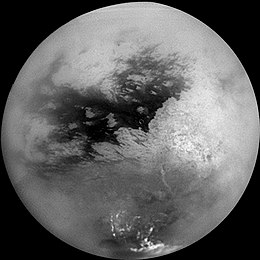Shangri-La (Titan)
 Shangri-La is the large, dark region at the centre of this image of Titan | |
| Feature type | Dark albedo feature |
|---|---|
| Coordinates | 10°S 165°W / 10°S 165°WCoordinates: 10°S 165°W / 10°S 165°W |
| Eponym | Shangri-La |
Shangri-La is a large, dark region of Saturn's moon Titan at 10°S 165°W / 10°S 165°W[1]. It is named after Shangri-La, the mythical paradise in Tibet.
It is thought to be an immense sand sea of dark, organic material, one of three major equatorial sand seas on the moon (the others being Belet and Fensal).[2]
Shangri-La is studded with bright 'islands' of higher ground, called inselbergs, which are thought to be protrusions of the icy bedrock. [2] The composition of the sand itself is unknown and a current area of research, although orbital observations strongly suggest organic compounds. It has been speculated that the sand may have eroded from sources that no longer exist, although other hypotheses, such as transport of evaporites from hydrocarbon seas and precipitation of organics from the atmosphere have been proposed.[3]
The Huygens probe landed on the west part of Shangri-La, close to the boundary with Adiri. The planned lander rotorcraft Dragonfly will land on Shangri-La, and will fly toward the Selk impact crater.[4]
References[]
- ^ "Shangri-La". Gazetteer of Planetary Nomenclature. USGS Astrogeology Research Program.
- ^ a b Lucas, A.; Rodriguez, S.; Lemonnier, F.; Le Gall, A.; MacKenzie, S.; Ferrari, C.; Paillou, P.; Narteau, C. (2019). "Texture and Composition of Titan's Equatorial Sand Seas Inferred From Cassini SAR Data: Implications for Aeolian Transport and Dune Morphodynamics". Journal of Geophysical Research: Planets. 124 (11): 3140–3163. Bibcode:2019JGRE..124.3140L. doi:10.1029/2019je005965. ISSN 2169-9097.
- ^ Bryan, Yu, Xinting Hörst, Sarah M. He, Chao McGuiggan, Patricia Crawford (2018-06-20). Where does Titan Sand Come From: Insight from Mechanical Properties of Titan Sand Candidates. OCLC 1098137557.
- ^ NASA's Dragonfly Will Fly Around Titan Looking for Origins, Signs of Life. Grey Hautaluoma and Alana Johnson, NASA. Press release 27 June 2019.
- Surface features of Titan (moon)
- Astrogeology stubs

